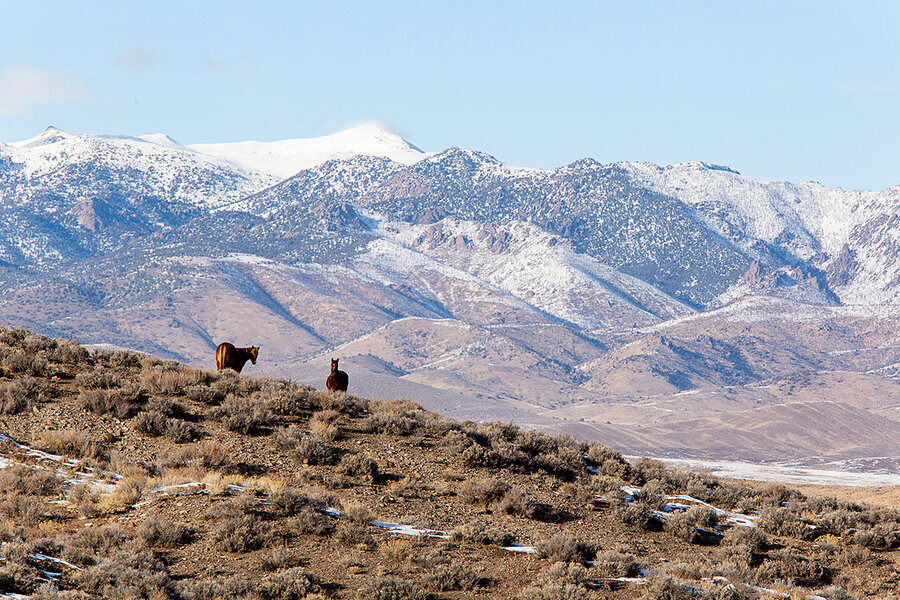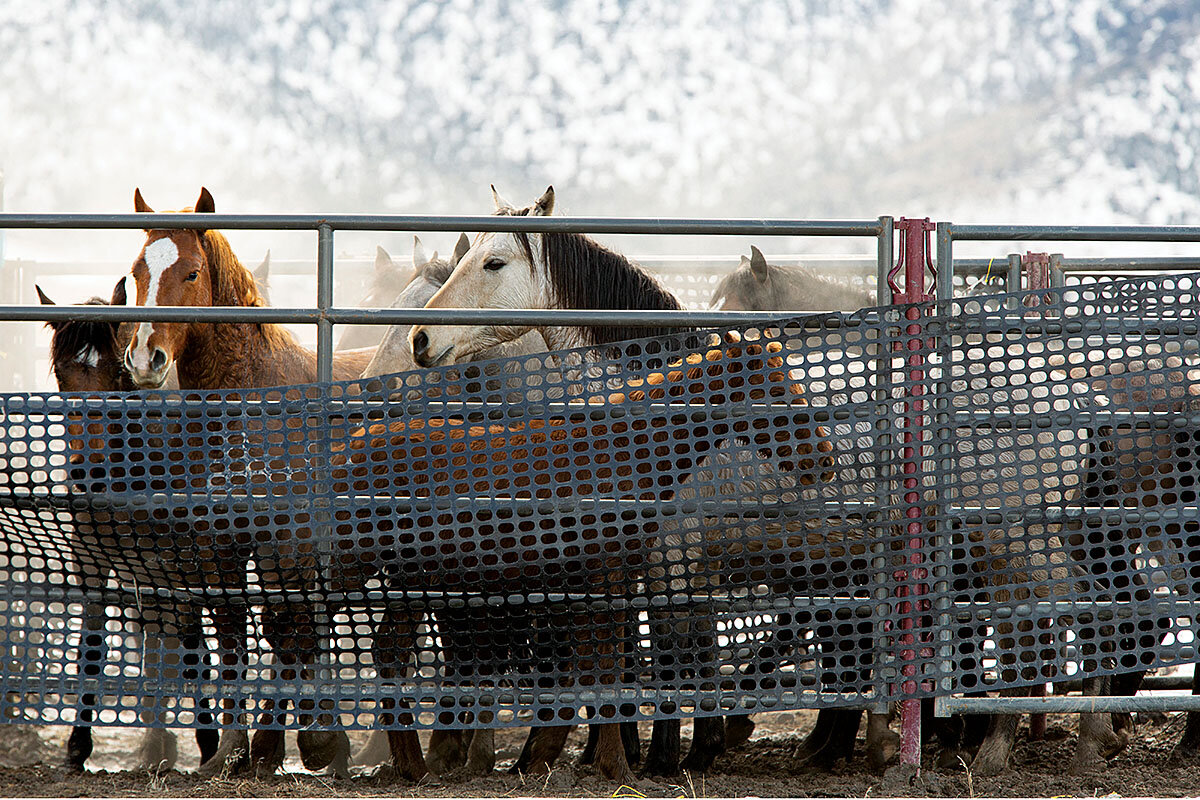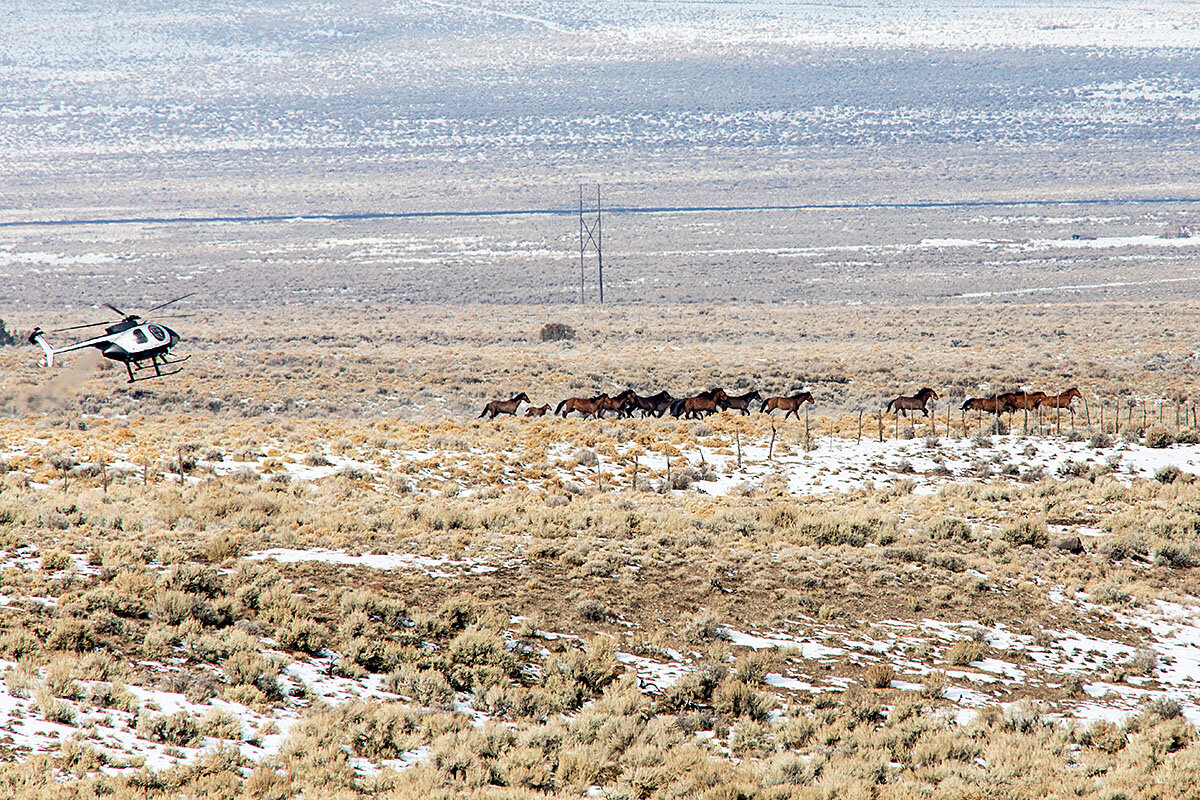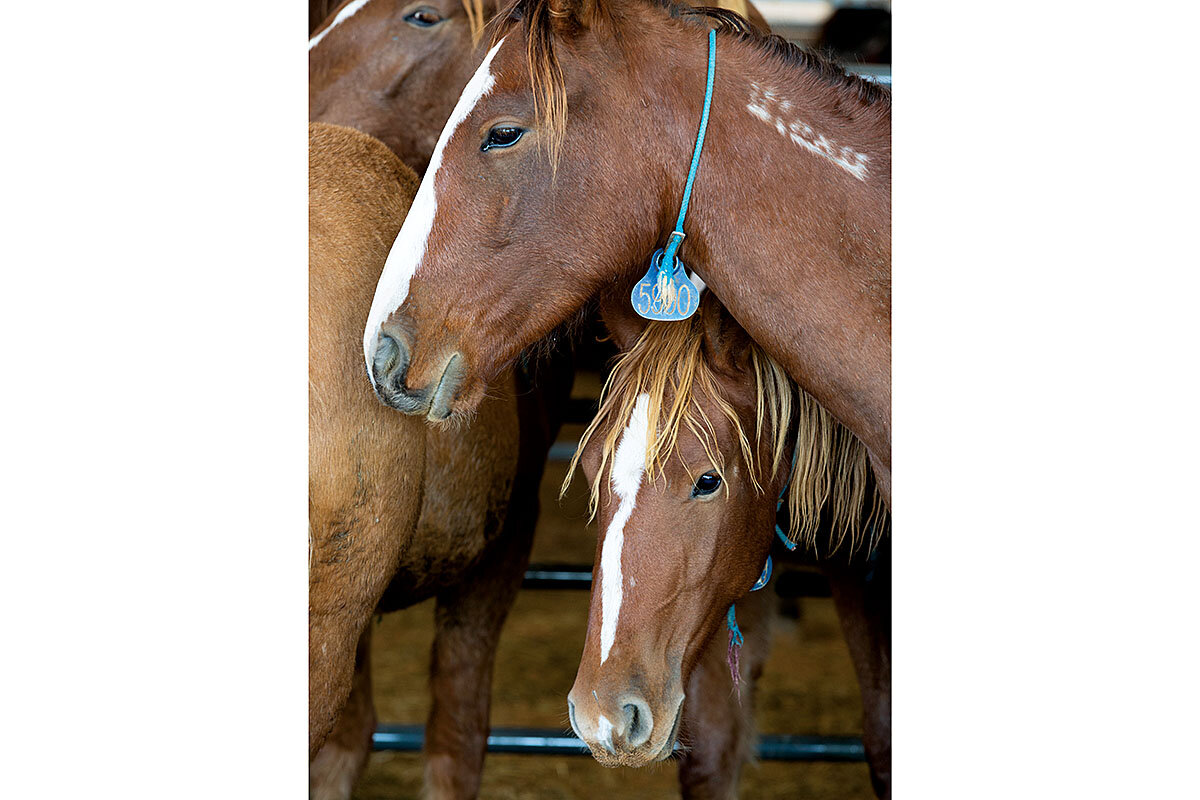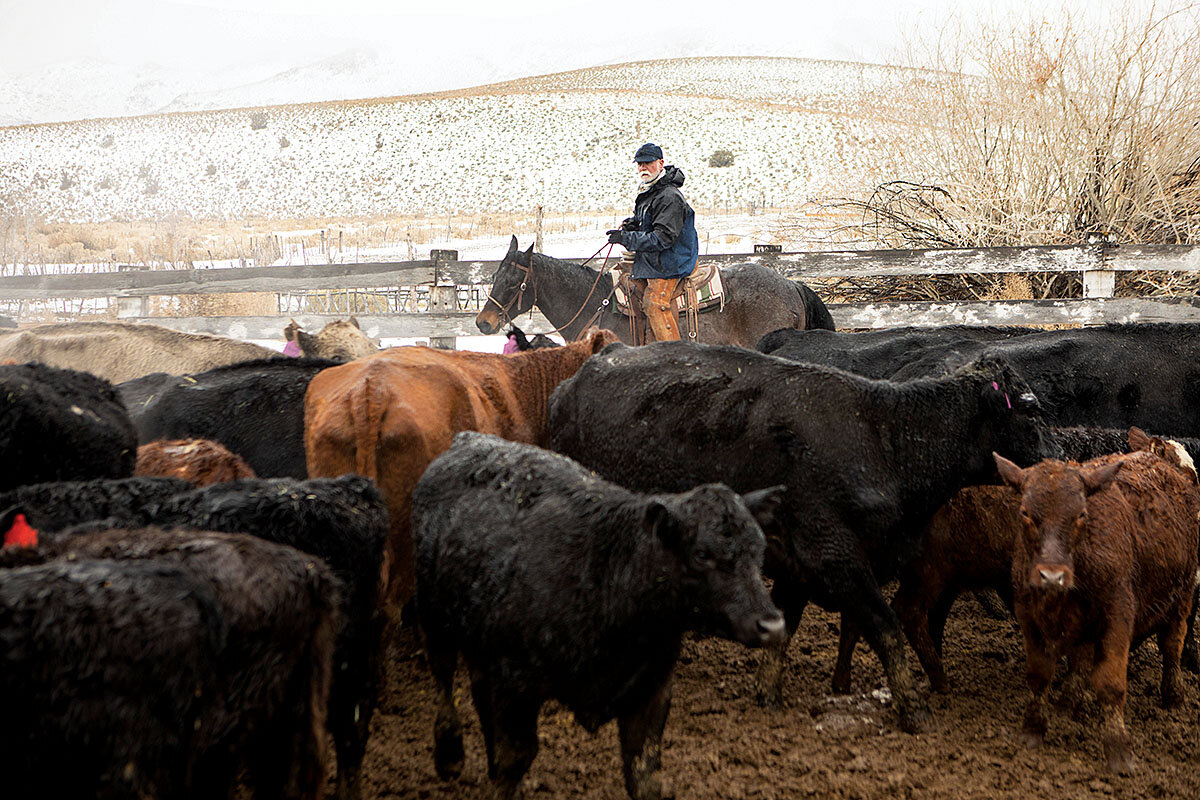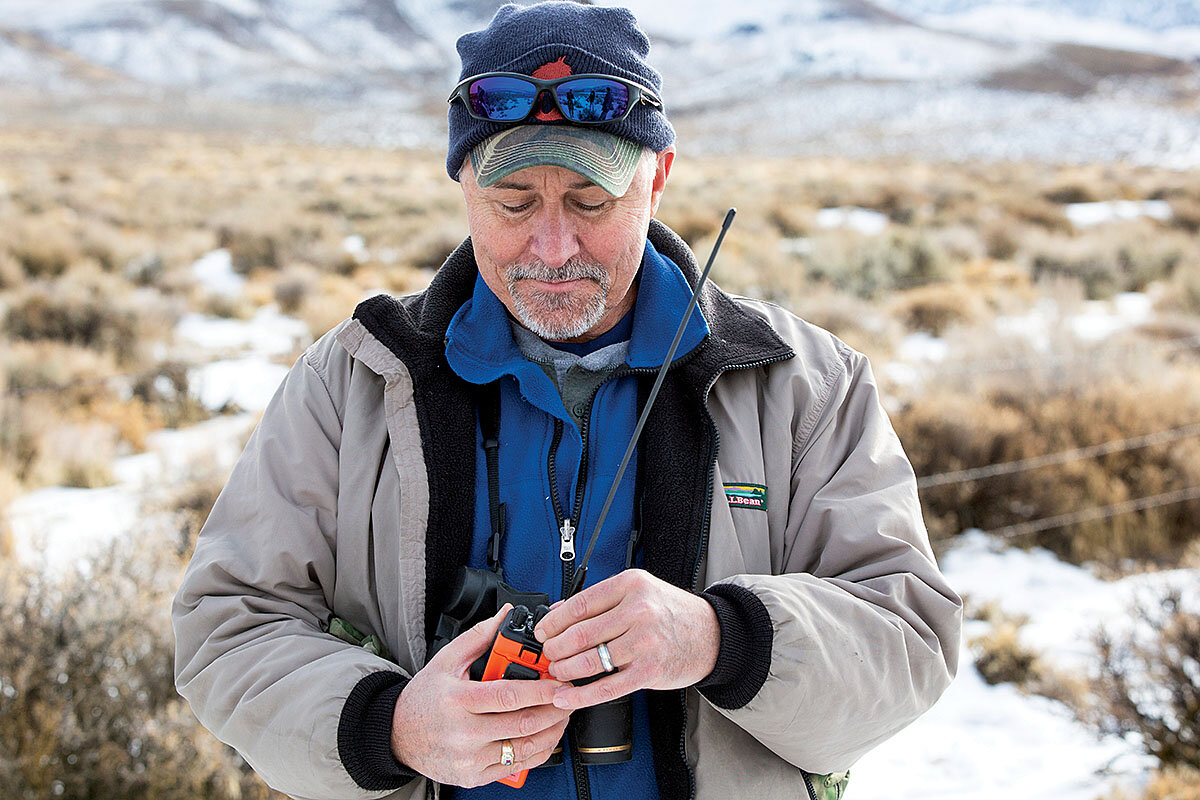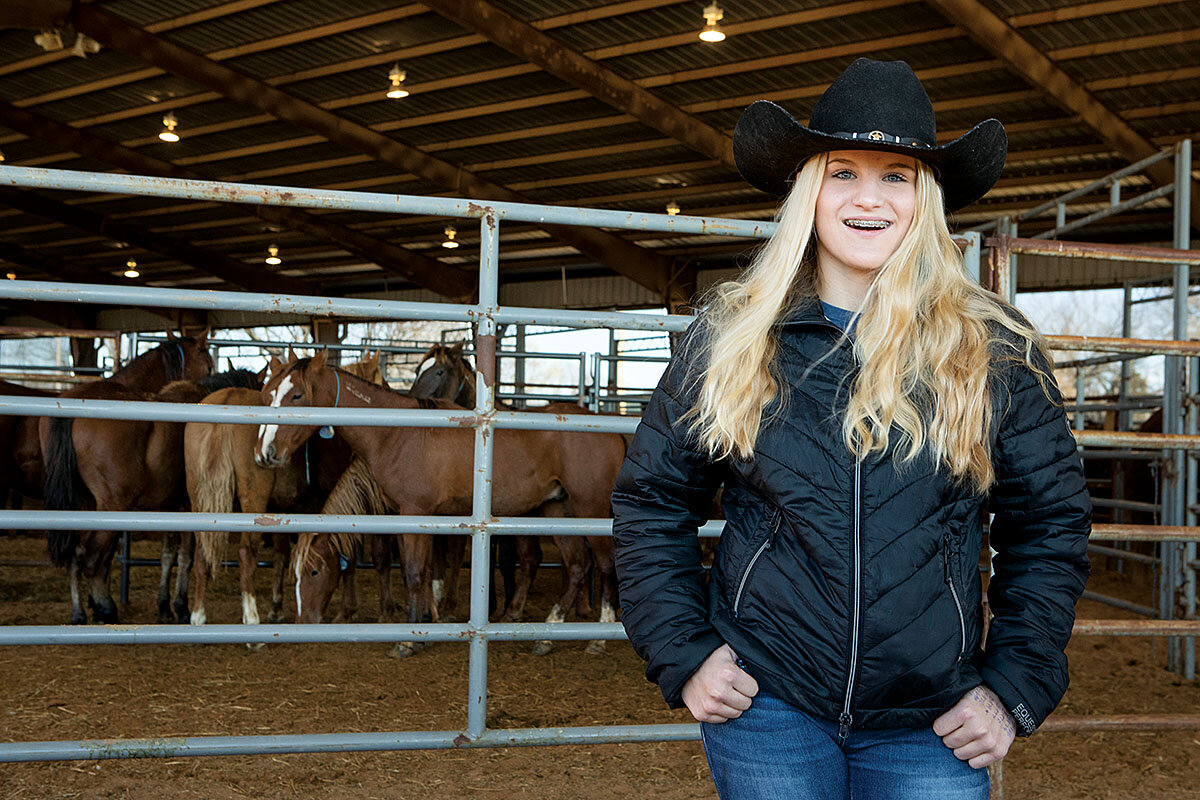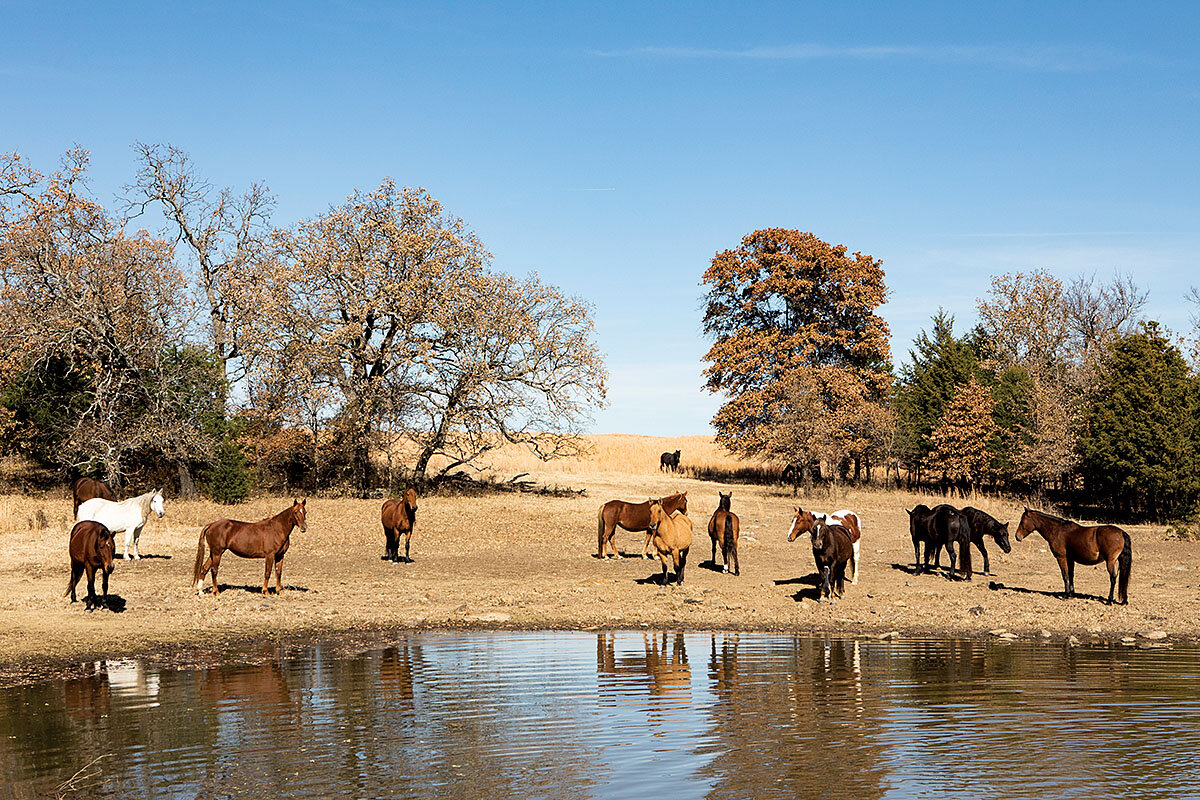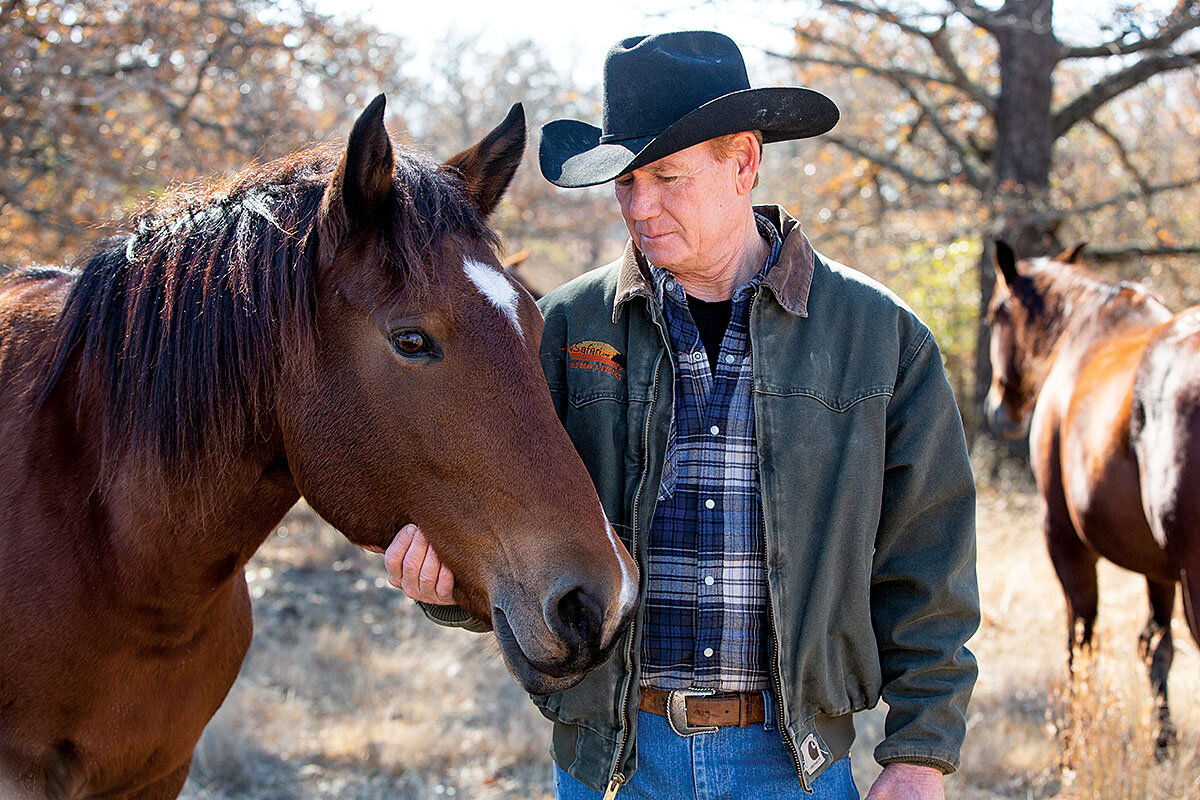Taming an American icon: Can we protect wild horses and Western lands?
Loading...
| Desatoya Mountains, Nev.
When the first wild horses come into view, thundering through high desert sagebrush, it’s easy to imagine they’re in the American West of 150 years ago. This part of Nevada is desolate and beautiful: massive plains that stretch for miles without a building – or tree – in sight, rugged snow-gauzed mountains piercing the sky.
But if the idea of wild horses is a romantic one in America, conjuring images of unfettered freedom and unfenced spaces, the reality, in today’s West, is far more complicated. These horses – herded by a helicopter and headed for relocation to private pastures or adoption – lie at the nexus of a human-wildlife conflict that is one of the most incendiary in the West. It is a dispute rife with emotions and with little common ground.
Wild horses may be beloved in America, but to some, they’re also a nuisance – a remarkably fecund one, with a population that grows by about 20% a year, wreaking havoc on rangeland vital to ranchers and other wildlife. Estimates put the wild horse and burro population at 88,000 on public lands as of this past spring, though most experts say it’s now closer to 100,000. That’s more than three times the target population of 26,700 that the U.S. Bureau of Land Management believes its herd management areas can sustainably support.
Why We Wrote This
The emotional debate over the growing number of wild horses in the West is about more than animals and public lands. It’s about people and values, which is why a compromise has been so elusive. Is one now at hand?
With limited resources and management options constrained by law, court order, and public opinion, the BLM is trying to handle the horses through a piecemeal solution of roundups, adoptions, and maintenance on taxpayer-funded private lands. But it’s a system that satisfies no one, is expensive, and is leading to growing populations of horses both on and off public rangeland.
“It’s like a runaway freight train, and it’s not easily solved,” says Dean Bolstad, who retired from the BLM in 2017 after 44 years with the agency. “I can’t tell you how important [dealing with these animals] is to the health and well-being of public lands.”
Now, for the first time in years, there are glimmers of a solution. A broad coalition – including both animal-welfare groups and ranching organizations – has put out a plan that it believes offers a way forward. It expands roundups and adoptions in the short term, and proposes a massive increase in fertility control measures to keep populations stable in the long term. The downside: It’s expensive (and requires congressional allocation of funds) and faces fierce criticism from major wild horse advocacy groups, which believe that the plan will pave the way for slaughtering the animals.
Still, those involved in formulating the plan say it represents a monumental undertaking in which groups used to warring with each other worked hard to lay aside differences.
“It was painful. ... No one liked the information once we dug into these numbers,” says Celeste Carlisle, a biologist with the wild horse advocacy group Return to Freedom, which has taken some flak from other horse groups for its endorsement of the proposal. “But nothing is going to be achieved unless you actually listen to what people are saying, and listen without your own biases.”
This is a debate that on the surface is about animals and public lands but is more fundamentally about people and values. That’s a big reason why finding a resolution has been so hard.
J.J. Goicoechea, a fourth-generation Nevada rancher who was also part of the Path Forward proposal, says it’s been challenging getting ranchers to agree to the compromise as well. But, like Ms. Carlisle, he thinks a plan with broad support is the only option. Mr. Goicoechea says he understands the emotional attachment to wild horses that lies at the root of the debate. “We’re not anti-horse,” he says. “They’re a part of the American West. The West evolved with the horse. Unfortunately, they’re now taking over, and the West is evolving again.”
For an animal that seems quintessentially American, the wild horse is actually not native, and technically, not wild. Today’s wild horses all descended from domesticated horses, many brought over by the Spanish in the 1500s, intermixed with a variety of other breeds. But with a durable recent history and an even longer ancient history – their ancestors roamed Wyoming 3 million years ago, and horses may not have disappeared completely from North America until about 10,000 years ago – some horse lovers prefer to refer to them as a “reintroduced” species.
“They represent the West,” says Greg Hendricks, director of field operations for the American Wild Horse Campaign, out in the Desatoya range to observe the recent December roundup. “They earned a spot. They fought in our wars, did all the things that you would expect to earn a spot. And that’s why I work to try to keep them here.”
Wild horses are charismatic and easy to love. They also happen to reproduce quickly – starting at a young age and continuing throughout most of their lifespan – and have few natural predators. When forage is scarce, they’ll eat what’s available down to the root, making it difficult or impossible for vegetation to recover.
Wild horses also enjoy an extraordinary amount of protection. A massive public campaign in the 1950s and ’60s helped get the Wild Free-Roaming Horses and Burros Act adopted in 1971, setting the baseline for the current management system and making it illegal for private citizens to round up, herd, or kill horses. Subsequent congressional action and court cases have also limited management options – most notably, ensuring that no horses on federal land end up killed or sold to slaughterhouses in Mexico or Canada.
Herd management areas, or HMAs, exist in 10 states, but Nevada, with more than half the wild horses in the United States, is ground zero in the conflict. In the Desatoya management area, where the action is focused on this blustery day, the BLM has determined that the “appropriate management level” is between 127 and 180 horses. As of July, the herd numbered about 560.
Ray Hendrix, the main rancher with grazing allotments on these rangelands, expresses frustration about what the horses are doing to the land. In late August, he visited what he calls the “lower country,” where he planned to graze some of his 900 cows this winter. He was thrilled to see abundant “winterfat” – a nutritious shrub that makes for excellent winter forage.
“I thought, this is fabulous. We’ll turn out this fall and there will be a lot of feed,” says Mr. Hendrix, a no-nonsense rancher in a baseball cap and Carhartt jacket. “Then I go back in October and it’s all gone. The horses ate it.”
He’s hopeful that since the BLM is removing horses, the natural scrub will revive. But in some places, particularly along rivers and streams, he’s seen damage that he thinks can never be undone.
Like most ranchers in Nevada, Mr. Hendrix grazes his cattle almost exclusively on public lands. He’s trying to use the landscape responsibly. But the horses, he says, make that challenging.
“How do you deal with something you can’t manage?” he asks. “Even if we herd those horses, we’re breaking the law. ... Just think of what 600 animals that you cannot manage are going to do to the resource.”
For many horse advocates, the problem isn’t the wild mustangs. It’s the cattle. The horses, they argue, have more of a right to these lands than the cows. But even for those activists who acknowledge that burgeoning horse populations are an issue, they’re troubled by the trauma of helicopter roundups and the lack of serious efforts to use fertility controls. They see management practices tipped against the horses.
Steve Paige, a quiet man with white hair, attends as many of the BLM “gathers” as he can, wielding a camera with a long lens to document the process. A field representative for the American Wild Horse Campaign, Mr. Paige hopes that his presence adds a layer of accountability to the operation. At the Desatoya roundup, he mixes easily with the BLM employees, though at some of the other gathers, he acknowledges, “they hate me.”
Mr. Paige lives in Reno, Nevada, but his first involvement with horse advocacy came almost 30 years ago, when he lived in Los Angeles. He attended an auction and saw one man buying up as many horses as he could, for $300 apiece, with the intent, he presumed, of selling them for slaughter. When the man bid on a small Arabian, Mr. Paige suddenly found himself bidding on it, too – with no way to transport or board the horse.
“She was the most beautiful horse I had seen,” he says. “My only regret is that I couldn’t buy more that day.”
The Desatoya gather goes relatively smoothly. On the first day, about 80 horses are rounded up, and then separated into gender-separate groups. The first band has a foal with it, but the helicopter moves the herd slowly enough that the foal can keep up. As the horses near the trap site, contractors release a “Judas horse” – a trained mustang that runs into a fenced-off area luring the wild band with it.
Mr. Paige says he’s seen horses run so fast that foals can’t keep up and die overnight. “There’s good days and bad days,” he says. His style with the BLM handlers is reserved rather than confrontational, and when he sees a potential problem, such as barbed wire near the pen site, he suggests they mark it to ensure horses don’t get hurt.
Ken Collum, manager of the BLM’s field office in Stillwater, Nevada, is overseeing this gather. A geologist with a dry sense of humor, he peppers his conversations with anecdotes from his years working in Central America. As he observes the progress of the roundup, he fields regular calls both from his office in Carson City and from the Navy, which is conducting jet fighter exercises overhead. Contrails slash the skies as the horses run below.
The toughest aspect of wild horses, says Mr. Collum, is seeing how hard they are on the land as well as the constraints they put into any management plan.
“We don’t manage species – except horses, for some reason. We manage the habitat,” says Mr. Collum, as he drives through the lands adjacent to Mr. Hendrix’s ranch, stopping periodically to note where cheatgrass, an invasive annual plant, has taken over. Most of these lands have been overgrazed for years and bringing them back to health is already challenging, he says. Growing horse populations affect “our ability to manage grazing and just about everything.”
A few weeks earlier, mustang lovers and BLM officials were gathered in Ardmore, Oklahoma, for one of the least controversial portions of any wild horse solution: an adoption event. Emotions run high here, too, but in this case, they’re positive. Potential adopters eagerly look over untamed horses in pens; past adopters have brought their mustangs with them for an annual horse show.
In corrals, groups of eight to 10 mustangs stand together, wary of anyone who approaches. Handlers separate the ones already claimed, pushing them into chutes and eventually waiting trailers.
Kayden Laymance, tall and blond, with braces, a black cowboy hat, and an irrepressible grin, watches excitedly as two horses get loaded up. The 14-year-old says she has wanted to adopt a mustang ever since she first came to this event three years ago. Her family has three horses at their farm in Gainesville, Texas, and Kayden has worked with “problem” horses before, but these will be the first she’s broken entirely by herself. “I’ve never gotten to start a horse,” she says. “I get to put the first ride on it. It’ll be awesome.”
This is what the BLM would like to see: more mustangs off the range and adopted by responsible owners. But finding homes in enough numbers has always been a challenge, and BLM officials acknowledge that adoption, by itself, can’t solve the problem. Still, this year, in an effort to boost the process, the BLM began offering an incentive: It will pay up to $1,000 to anyone who adopts a horse. Adoptions, which were flagging, have started to climb. In fiscal year 2019, people took home more than 7,000 horses – the highest number since 2005 and a 54% increase over the previous year.
The incentive program wasn’t the main reason the Laymances decided to adopt their mustangs, but it helped. Money can be tight in a family with seven children, and Whitney Laymance, Kayden’s mother, hopes the stipend will offset some of the costs of caring for the horses.
But mostly Ms. Laymance is excited about what this means for Kayden. “This is our mom-daughter project,” she says. “It’s giving my daughter and me the gift of bonding over what we are both most passionate about.”
Past adopters are, if possible, even more enthusiastic. Carol Wandell, who teaches horseback riding in Gainesville, has been working with mustangs for about 30 years – ever since her son, at age 13, decided he wanted a horse and bought an untrained mustang from a friend. “It took two years before my son could even ride the horse,” she laughs. “We had no idea what we were getting into.”
Over the years, she and her daughter-in-law have adopted about 15 horses and burros, and breaking them has been a rite of passage for several of her grandchildren. “It transforms the kids,” she says. “Every time I go to one of these places, there always seems to be one that touches my heart, and you end up bringing it home.”
Still, adoptions, even in increased numbers, can’t reduce the populations to a sustainable level. Many of the horses instead end up on private lands, at a cost to taxpayers of nearly $50,000 per animal over the course of its lifetime. Currently, about two-thirds of the BLM wild horse and burro budget goes to maintaining these horses.
For the animals, it’s not a bad life. At Mowdy Ranch Mustangs in Coalgate, Oklahoma, more than 360 mares roam a 4,000-acre ranch. They graze and gallop amid grasslands, woods, and rolling hills.
When they first got there, Clay Mowdy notes, many of the horses were terrified of trees. Now they’ve adjusted to the environment, just as others have adjusted to the presence of people. (The Mowdys run a guest ranch.)
Occasionally, says Mr. Mowdy, activists come who are certain the horses must be suffering. “They leave happy,” he says, as he drives over the ranch in a pickup, two of his dogs in the back. “I don’t think we’ve ever had anyone that’s gone away without their position changed quite a bit.”
The big, but often unspoken, issue surrounding wild horses is slaughter. Plenty of people who have worked on wild horse issues for years acknowledge that killing them would be the most cost-effective and efficient way of dealing with overpopulation.
But even those who favor it as a solution admit it’s unlikely that it will ever be politically palatable. Horses are too beloved; the scenes of their suffering in slaughterhouses in Mexico or Canada too vivid. Killing horses “is not going to fly,” says Mr. Bolstad, the retired BLM official.
With that option unavailable, most experts agree that a massive investment in some sort of fertility control has to be a centerpiece of any plan going forward. But it isn’t easy to do. While the vaccines used are improving, a large number of mares in a herd – perhaps 80% – need to be treated to actually keep population growth in check. The initial vaccines don’t last long. A second booster shot is more effective, but rounding up horses is expensive, and by the time a second shot is given, many of the original mares have had foals, which are also producing offspring.
“It’s like trying to plug a dam with your finger,” says Mr. Hendrix, the rancher.
But critics of the BLM argue that the agency has never truly given fertility control a chance, other than with a handful of small herds. The longer-acting version of PZP, the most common fertility vaccine, has been in use since 2004, notes John Turner, an endocrinologist at the University of Toledo who has been working with vaccines for decades. “The BLM created the crisis by not taking action. ... They’ve had 15 years to do something about it, and they’ve just continued to do what they do,” says Dr. Turner.
The American Wild Horse Campaign recently began working with the state of Nevada to manage a herd of 3,000 horses on state land outside Reno. In just seven months, spokeswoman Grace Kuhn says, 14 volunteers have injected over half the mares with vaccines – more horses than the BLM treated nationally. While initiatives like this are impressive, many believe it will take a multifaceted approach to solve the overall wild horse problem, something like the Path Forward proposal of the coalition.
“This is our best effort to come up with something that can change and revolutionize this program,” says Stephanie Boyles Griffin, a senior scientist at the Humane Society of the United States.
Through an increase in roundups, expanded adoptions, relocating unadopted horses to more cost-effective pastures, and – most importantly – treating about 90% of the mares returned to the range with fertility measures, the groups believe they can get numbers to more reasonable levels within 10 years.
The problem with this approach, say critics, is that it will cost so much in the short term that it will lead inexorably back toward slaughter. For wild horse advocates like Ms. Kuhn, that is a practice that should never be broached again. “This Path Forward is the antithesis of that,” she says.
A day after the Desatoya roundup, the corralled horses inhale hay in their new surroundings at an adoption facility outside Reno. The small foal is still with its mother. What will happen with it next – a new home with someone like the effervescent Kayden Laymance, a new life on a cinematic ranch like Mowdy’s?
The 1971 law designed to protect wild horses called them “living symbols of the historic and pioneer spirit of the West.” But finding a compromise between those idealistic values and the pragmatism of the people who use the West’s vast public lands defies easy solution. What everyone agrees on is that the current path is untenable – and maybe that alone is enough to inspire a way out.
Mr. Goicoechea, the Nevada rancher, explains the futility of the status quo with characteristic grit. “I’ve seen horses eat sagebrush down to the stump,” he says. “I’ve seen them eat their own manes and tails.”
While it’s easy to view this issue through the lens of extremists on both sides, the reality is most people realize its complexities; they just come down differently on whether to tilt the scales toward horses, ranching livelihoods, or the overall ecosystem. Ms. Boyles Griffin, who works on numerous “human-wildlife” conflicts for the Humane Society, says this one is the most challenging.
“All of the stakeholders involved are driven by unique values and attitudes toward wild horses for good or bad,” she says, “and people have a tremendous amount of identity associated with their view of how these animals should be managed.” In the broad middle, she says, are people who care about both horses and the land, and want to make sure they’re managed humanely and sustainably. “I think the majority of people on this issue want that; they just have different opinions on how to get there.”




